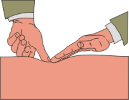
Intensity in ultrasonotherapy
Automatic translation from Spanish
Is there intensity in ultrasonotherapy? I propose that the usual W/cm2 parameter should not be named as intensity. Why?
In electrotherapy it is very common to "turn up the intensity" in TENS, in stimulators, in the US, in micro wave, in laser, in everything of everything; and what a colleague told me about this may happen with a patient.
He told me that he intended to apply a session of laser therapy, I speak to raise the intensity, the patient asked what the parameter, he replied that in watts, he asked a couple more questions about the risks, the patient perceived a lack of security and concepts confused; the patient refused to receive the session from her.
--"Swallow me dirt and what a shame" --the partner commented to me.
For these issues of lack of professionalism: one of my struggles
focuses on clarifying the concepts and unifying the nomenclature of
our techniques (and especially in dosage). So, picking up the thread.
What is usually called intensity in ultrasound therapy?
To the quotient of dividing the power emitted by the entire head by the effective emission surface of the head in cm2 [W/cm2]. Logically, if the dividend is POWER, the quotient will be POWER. Do you want to give the quotient another name other than power? well ok . . . Everyone is free to make their own mistakes.
Where does the concept of intensity in sound waves come from?
By dividing the power emitted by a point or sound origin (which is expands in spherical waves) between the surface of a cap spherical of said sphere, whose surface of the cap is 1 m2. The dividend is POWER and the quotient should be POWER but it is called SOUND INTENSITY in [W/m2] of a spherical cap inside the sphere.
Is it the same to work with standard sound as with US emitted by a focused head? I think no.
- The standard sound is emitted in all directions and the formula intensity drop is [W / 4πr2] (power between area of the sphere) and consequently the sound loses intensity of inverse of the square of the distance, or the radius of the sphere in this case. The standard emission of sound is a beam divergent in all directions.
- The ultrasonic beam emerges from the flat surface of the head, advances in a straight line (tending to converge on the first centimeters) by the medium that leads it and is applied directly to a receiving surface that matches the size of the head emission or ERA, and that does not depend on any formula, simply because it equals the ERA.
- The standard sound is output in watts [W] at the source point and advances in all directions suffering loss of power with the distance, inversely as the square of the distance.
- The US of the ultrasound head is also emitted in watts [W ] that emerge throughout the ERA of the head and are transmitted to the same surface of the conductive element, without considering the BNR.
- Is it necessary to find the density of the energy emitted by the head for each cm 2 of the ERA? Not really, but for habits and customs of the old ways to apply ultrasonotherapy, usually if used. See the formula below.
- Is there the same relationship dividing the power by the surface in both cases? Well, no; since in the sound said calculus has a totally different function and you need to know that quotient times the divergence of the beam. But in the US, the beam tends to be parallel (by focusing the head), it would not suffer power losses in its advance if the medium were perfect. Is similar to the laser beam, when the beam of rays tends to be parallel.
- Why am I proposing that W/cm2 not be called INTENSITY? First : because the unit of intensity in sound is W/m2 (power between meters of a spherical cap) that does not have nothing to do with the case of the head that is flat and in cm2. Second : because if there are power losses they are not due to distance, but by other factors depending on the interfaces of the medium, of good contact, etc., but they are not comparable to standard sound on air. Third : because the intensity nomenclature in ultrasonotherapy leads us to misconceptions and comparisons with electric waves, which they have nothing to do with this case. Fourth : The parameter of W/cm2 is not really needed for the formula dosage that I propose based on the J/cm2 of the treated surface. See formula below. Fifth : The ratio of W/cm2 may be important to consider due to the different sizes of the heads, in order to keep the concept of energy density even if different heads.
- How do I propose to name the quotient of W/cm2? Simply: HEAD POWER DENSITY.
- Can it be considered as INTENSITY? Okay . . . But I think that this tends to maintain the old system of applying ultrasonotherapy "in that way" so unscientific and slows the advance towards improvement in the technique of ultrasonotherapy.
- When dosing should preferably consider the concept of EFFECTIVE POWER ISSUED BY THE WHOLE HEAD, which proceeds of the dosing formula divider: [W/cm2 * ERA * ratio pulse:repose]. Concept that will help to better understand the formula of dosage.
Yes, it would be appropriate to call the ULTRASONIC INTENSITY the quotient between power and surface when dividing the head power into watts across a surface covered by the beam, but at several centimeters deep in the tissues (at X distance from the head), without forgetting that this surface has to be expressed in m2; However, the power that emerges for each cm2 of the head is a different concept.
Dosage formula
Actually the dosage formula is based on a concept very simple physics:
Work = power divided by time
Power = work divided by time (and ours)
time = Total work / Effective power of the entire head
Remember that:
- time has to go in seconds [s],
- the work in Joules [J] coinciding with the energy applied to the end of session and
- the power in Watts [W] or work done in just 1 s
But the technique usually requires that:
- we set the time in minutes and it will have to be converted,
- that are used of different sizes of heads and ERAs,
- the possibility of adjusting continuous or pulsed,
- that somewhere you have to include the size of the treated area,
- and the fundamental, How much energy do we want to result
deposited in the patient at the end of the session, that is, the
dose in J/cm2? But it is decided before start the
application.
So, let's go by parts:
What is the total work equal to, in J? = J/cm2 on the treated surface, by the treatment area in cm2 = a DOSE per SURFACE TREATED = J/cm2 * S in cm2
The numerator or dividend of the equation is already solved. Let's go now with the denominator or divisor of the formula.
What is the same effective power of the entire head? = DENSITY OF POWER per REAL EMISSION AREA per PULSE REASON: REST = W/cm2 * WAS * %
If your US equipment has a choice between adjusting watts per square centimeter or head watts, you no longer need to include in the formula neither the power density nor the ERA, only consider whether you work in pulsed or continuous mode.
Thus, the Joule formula of physics with the three terms Fundamentals, developed, results as follows:
Being:
- t = time in seconds
- J = Total joules throughout the session
- W = power in watts of the entire head (power is the 1 second work)
- J/cm2 = Dose in Joules to be deposited at the end of the session in each cm2 of the treated area
- S en cm2 = surface of the treated area
- W/cm2 = power in watts emitted per cm2 head
- ERA = real ultrasonic emission area of the head in cm2
- % = pulse factor correction or continuous set to machine
Generic formulas that are applied in light should not be mixed, radio frequency and in the standard sound NOT FOCUSED (when they release in the middle in all directions); with the formulas used when focused on highly directional beams that tend to maintain the parallelism of their emission waves. See the work on the Law inverse of the square of the distance for the light output.
Ultrasonic beam
It is formed by a nearby zone (Fresnel) a focal zone (with its focal point) and a far area (from Fraunhofer).
- In the near zone, normally, the beam tends to be convergent
- At the focal point the beam can have a diameter about half the ERA
- In the far zone the beam diverges and loses energy
- Focal length is the distance between the emitting surface head and focal point
- The focal zone is made up of part of the near and the far close to the focal point
- The greatest therapeutic effect occurs in the focal zone
The conversion of kinetic energy into thermal energy occurs with greater efficiency in the focal zone, or nodule of maximum power, because the diameter of the beam can be reduced by about half ERA diameter.
The head size, the head BNR, the frequency, the largest or less head focus and adjusted power; are factors that influence the focal length and the greater or lesser penetration in soft tissues.
Ultrasonic penetration into soft tissues is very high. Other thing is its greatest energy conversion effect, which usually occurs near the head.
That the penetration is quite a few centimeters is shown by the ultrasound scan, where powers between 2 to 6 mW/cm2 are used, in Doppler up to 80 mW/cm2, with frequencies ranging between 2 and 10 Mhz.
The near field calculation is equal to:
- Near field = ERA / 4λ
- Being [ λ ] the wavelength that depends on dividing the speed in the middle between frequency.
- The mean velocity of propagation in soft tissues is consider 1540 m/s
If in the electrotherapy book I had gone as deep as in this article, the book would have two volumes; they already suggested to me to delete many paragraphs and topics in the third edition so as not to complicate electrotherapy excessively, as it is one of the criticisms made of me, "Rodríguez Martín has electrotherapy complicated a lot." Personally, I think that if we boast of scientists, you have to be up to the task.
Published on 07/01/2021 being a copy of it in ultrasonoterapia.com







